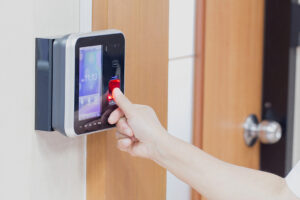
Maintaining secure access control is critical for many facilities and industries, restricting access to only those who require it.
In the age of digital transformation, where cybersecurity dominates headlines, it’s easy to overlook the significance of physical access control. However, ensuring the security of your physical premises is just as crucial as protecting digital assets. Physical access control refers to the mechanisms and practices used to regulate and restrict entry to buildings, rooms, or sensitive areas within an organization.
Comprehensive Access Control System
Invest in a modern, comprehensive access control system tailored to your organization’s needs. These systems typically include electronic access cards, key fobs, or biometric readers to grant entry to authorized individuals. Integrate the system with a centralized management platform that allows you to monitor and control access in real-time, enabling quick responses to security incidents.
Restricted Access Zones
Identify sensitive areas within your premises and implement restricted access zones. Only grant access to individuals who genuinely require it to perform their job duties. This principle of least privilege minimizes the risk of unauthorized personnel gaining entry to critical areas. If you’re unsure which areas should be restricted, consult a security professional that can perform an assessment of your property or facility and offer appropriate solutions.
Employee Identification Badges
One option is to issue unique identification badges to all employees and visitors. These badges should prominently display the person’s name, role, and photo for easy identification. Employees should wear their badges at all times while on the premises, and visitors should be accompanied by authorized personnel for maximum security. Keep in mind that badges can be lost, stolen, or even given to unauthorized persons to gain entry to your facility. They’re enough for some properties, but high-security facilities will need to look into other options.
Physical Barriers and Alarms
Deploy physical barriers such as turnstiles, security gates, and access-controlled doors to restrict entry to authorized points only. Additionally, install alarms and surveillance cameras at critical access points to deter potential intruders and provide evidence in case of security breaches.
Security Personnel and Training
Employ trained security personnel to monitor access points and respond to security incidents. These professionals should be well-versed in access control protocols and emergency response procedures. Regularly train security staff and employees on security best practices, emergency evacuation plans, and how to recognize and report suspicious activities.
Implementing Two-Factor Authentication (2FA)
For areas requiring an extra layer of security, consider implementing 2FA for physical access. This could involve the combination of a keycard or biometric scan with a unique PIN or password, making unauthorized access even more challenging.
Regular Access Control Reviews
Conduct periodic access reviews to ensure that access permissions are up-to-date and align with the employees’ roles and responsibilities. Promptly revoke access for terminated employees or those who have changed roles within the organization.
TRUST THE PROFESSIONALS AT ARK SYSTEMS
Located in Columbia, Maryland, ARK Systems provides unsurpassed quality and excellence in the security industry, from system design all the way through to installation. We handle all aspects of security with local and remote locations. With over 30 years in the industry, ARK Systems is an experienced security contractor. Trust ARK to handle your most sensitive data storage, surveillance, and security solutions.
Contact ARK Systems at 1-800-995-0189 or click here today. Check us out on Facebook and Twitter as well!
This entry was posted on Thursday, July 27th, 2023 at 10:11 am. Both comments and pings are currently closed.